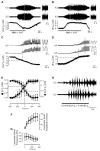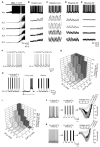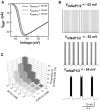Activity-dependent changes in extracellular Ca2+ and K+ reveal pacemakers in the spinal locomotor-related network
- PMID: 23522041
- PMCID: PMC3736142
- DOI: 10.1016/j.neuron.2013.01.026
Activity-dependent changes in extracellular Ca2+ and K+ reveal pacemakers in the spinal locomotor-related network
Abstract
Changes in the extracellular ionic concentrations occur as a natural consequence of firing activity in large populations of neurons. The extent to which these changes alter the properties of individual neurons and the operation of neuronal networks remains unknown. Here, we show that the locomotor-like activity in the isolated neonatal rodent spinal cord reduces the extracellular calcium ([Ca(2+)]o) to 0.9 mM and increases the extracellular potassium ([K(+)]o) to 6 mM. Such changes in [Ca(2+)]o and [K(+)]o trigger pacemaker activities in interneurons considered to be part of the locomotor network. Experimental data and a modeling study show that the emergence of pacemaker properties critically involves a [Ca(2+)]o-dependent activation of the persistent sodium current (INaP). These results support a concept for locomotor rhythm generation in which INaP-dependent pacemaker properties in spinal interneurons are switched on and tuned by activity-dependent changes in [Ca(2+)]o and [K(+)]o.
Copyright © 2013 Elsevier Inc. All rights reserved.
Figures



Similar articles
-
The persistent sodium current generates pacemaker activities in the central pattern generator for locomotion and regulates the locomotor rhythm.J Neurosci. 2008 Aug 20;28(34):8577-89. doi: 10.1523/JNEUROSCI.1437-08.2008. J Neurosci. 2008. PMID: 18716217 Free PMC article.
-
Low-threshold calcium currents contribute to locomotor-like activity in neonatal mice.J Neurophysiol. 2012 Jan;107(1):103-13. doi: 10.1152/jn.00583.2011. Epub 2011 Oct 12. J Neurophysiol. 2012. PMID: 21994264 Free PMC article.
-
Inward-rectifying potassium (Kir) channels regulate pacemaker activity in spinal nociceptive circuits during early life.J Neurosci. 2013 Feb 20;33(8):3352-62. doi: 10.1523/JNEUROSCI.4365-12.2013. J Neurosci. 2013. PMID: 23426663 Free PMC article.
-
Oscillatory circuits underlying locomotor networks in the rat spinal cord.Crit Rev Neurobiol. 2006;18(1-2):25-36. doi: 10.1615/critrevneurobiol.v18.i1-2.40. Crit Rev Neurobiol. 2006. PMID: 17725506 Review.
-
The neuronal network for locomotion in the lamprey spinal cord: evidence for the involvement of commissural interneurons.J Physiol Paris. 1995;89(4-6):221-33. doi: 10.1016/0928-4257(96)83638-2. J Physiol Paris. 1995. PMID: 8861820 Review.
Cited by
-
Calcium-Sensitive Subthreshold Oscillations and Electrical Coupling in Principal Cells of Mouse Dorsal Cochlear Nucleus.J Neurosci. 2024 Feb 7;44(6):e0106202023. doi: 10.1523/JNEUROSCI.0106-20.2023. J Neurosci. 2024. PMID: 37968120 Free PMC article.
-
Hyperexcitability of muscle spindle afferents in jaw-closing muscles in experimental myalgia: Evidence for large primary afferents involvement in chronic pain.Exp Physiol. 2024 Jan;109(1):100-111. doi: 10.1113/EP090769. Epub 2023 Dec 16. Exp Physiol. 2024. PMID: 38103003 Free PMC article. Review.
-
Effects of persistent sodium current blockade in respiratory circuits depend on the pharmacological mechanism of action and network dynamics.PLoS Comput Biol. 2019 Aug 30;15(8):e1006938. doi: 10.1371/journal.pcbi.1006938. eCollection 2019 Aug. PLoS Comput Biol. 2019. PMID: 31469828 Free PMC article.
-
Contributions of h- and Na+/K+ Pump Currents to the Generation of Episodic and Continuous Rhythmic Activities.Front Cell Neurosci. 2022 Feb 4;15:715427. doi: 10.3389/fncel.2021.715427. eCollection 2021. Front Cell Neurosci. 2022. PMID: 35185470 Free PMC article.
-
Riluzole for treating spasticity in patients with chronic traumatic spinal cord injury: Study protocol in the phase ib/iib adaptive multicenter randomized controlled RILUSCI trial.PLoS One. 2023 Jan 20;18(1):e0276892. doi: 10.1371/journal.pone.0276892. eCollection 2023. PLoS One. 2023. PMID: 36662869 Free PMC article.
References
-
- Brocard F, Verdier D, Arsenault I, Lund JP, Kolta A. Emergence of intrinsic bursting in trigeminal sensory neurons parallels the acquisition of mastication in weanling rats. J. Neurophysiol. 2006;96:2410–2424. - PubMed
-
- Brocard F, Tazerart S, Vinay L. Do pacemakers drive the central pattern generator for locomotion in mammals? Neuroscientist. 2010;16:139–155. - PubMed
Publication types
MeSH terms
Substances
Grants and funding
LinkOut - more resources
Full Text Sources
Other Literature Sources
Medical
Miscellaneous

